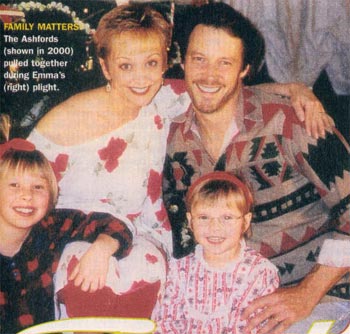|
Soap
Opera Weekly
The Power of Faith
DAYS'
Matthew Ashford reveals his daughter's struggle with
retinoblastoma -- and how it changed his family's perspective
on life |
|
|
WITH
THE LOVE AND SUPPORT of their family and friends
and the power of faith, Matthew Ashford (Jack,
Days of our Lives), his wife, Christina Saffran, and
their daughters, Grace, 10, and Emma, 5, survived a harrowing ordeal
in June. Emma, who had been diagnosed with retinoblastoma (an eye
cancer that effects children) at the age of 4 months, was brought
in for a checkup, and her ophthalmologist discovered a tumor that
ultimately led to the removal of her left eye.
"It
was a blow. It was horrific," reflects Ashford. "But it's
nothing that we can't handle. If it's right there in front of you,
[you have no choice] but to deal with it."
The nightmare began after a year and a half of positive feedback
from Emma's doctors. Having survived chemotherapy and nearly 40
laser surgeries in her young life, Emma had frequent check ups.
"Every now and then they would find another tumor cell. Doctors
get it with a laser when it was tiny," says Ashford, noting
that Emma was seen every three weeks until she was 3. "By then
the retina is pretty much developed. Most kids are out of the woods,
and Emma was looking good."
The span between follow-up doctor visits increased "to four
weeks, then five, then six," adds Ashford. "Eventually,
it was up to two months, three months.... This was the first six-month
period. During that time everything was going great. Emma was being
a normal little kid. We were trying to be normal parents."
All that changed, however, when Emma was preparing to go on a road
trip with her mother. "It was time for a checkup," recounts
Ashford, "and no one expected that there was going to be any
problem. But when the doctor [examined Emma], a tumor had been growing
an infinitesimal cell to six millimeters. That is huge inside the
eye. If we had waited another three weeks, who knows what would
have happened. It had to be dealt with." The tumor was too
big to laser, and the Ashfords decided against radiation. Instead,
they opted for a freezing treatment called cryotherapy, which was
performed immediately at Children's Hospital Los Angeles. "Emma
came home that night," recalls Ashford. "She was in some
pain, but she didn't show it."
 When the Ashfords took Emma in for a follow-up checkup, they learned
that while cryotherapy had destroyed Emma's tumor, "it had
also detached her retina fully. So what little vision she had was
gone in her left eye," he says. "Emma told me herself.
She put her had over her right eye and said, `Daddy, I can't see
you when I cover this eye.'"
When the Ashfords took Emma in for a follow-up checkup, they learned
that while cryotherapy had destroyed Emma's tumor, "it had
also detached her retina fully. So what little vision she had was
gone in her left eye," he says. "Emma told me herself.
She put her had over her right eye and said, `Daddy, I can't see
you when I cover this eye.'"
The loss of her sight was only a small part of the problem. "The
doctor could not see to the back of Emma's eye. He was concerned
that there may be something else back there, other possible tumors,"
explains Ashford. "Plus, the retina was folding up. Eventually,
Emma's eye would have shrunk and she would have been in pain. The
only thing to do was remove [the eye]."
It was a heartwrenching decision, but the Ashfords found a strong
support system. "We called Michael and Hunter Tylo (Taylor,
The Bold and the Beautiful) right away," remembers
Ashford. (The Tylos' daughter Katya, 4, had endured the same surgery
years earlier.) "We called relatives. [My wife and I] are both
Buddhists, and we had a lot of support from friends in faith who
changed with us, for us, and for Emma. We realized that this is
another step in the mission -- where we're going and where Emma
is going."
The Ashfords refused to wallow in self-pity. "There are a lot
of people hurting out there with all sorts of pain, whether it be
spiritual, physical or emotional," muses Ashford. "Everyone
is going through something or has gone through something. Everyone
has a strong desire to be haply. How we go about that is
what is important. Emma is a reminder of that for me.
So the family counted their blessings. "There are people in
worse situations," Ashford points out. "Children who have
already had one eye removed and are fighting to save the vision
in their last eye. There is a possibility that you will gamble to
keep your child's vision and you'll lose the child, because the
tumor cells might grow right up the optic nerve and into the brain.
That is a hellish situation to be in. We were not in it."
Still, the Ashfords did have the daunting task of preparing Emma
for her operation. "We did that with the help of counselors,"
says Ashford. "They [explained to Emma] that there were some
bad cells in her eye that needed to come out. The point is to actually
tell them what is happening and what is going to happen. Emma dealt
with it well and is continuing to deal with it."
She did have some concerns about the prosthetic eye she would be
receiving, however. Particularly, the fact that her "new and
beautiful eye," as everyone was referring to it, wouldn't be
able to see. "Emma didn't think that as fair states Ashford.
"But I pointed out that her old eye wasn't seeing anyway, which
she couldn't argue with."
Ultimately, Emma's left eye was removed, and an implant was inserted
into the socket. "It's a relatively simple operation. It took
two hours," says Ashford, adding that while Emma was heavily
sedated, she was treated as an outpatient. By the next day, she
was pretty much pain-free.
Some six weeks later, after the swelling subsided, Emma went for
her first fitting for her prosthetic eye. "That was
difficult," admits Ashford. "It's like a huge contact
lens that has to go in and come out from under the eyelid about
seven, eight, nine times, because the ocularist is shaping and shaving
it and seeing how it moves. Emma had reached her limit and did not
want anyone messing with her."
Finally, after three visits, Emma's new eye was finished. "The
ocularist put it in, and Emma hopped off her seat, went over to
the mirror, and said, `Oh! I look like me again,'" Ashford
smiles. "Emma went to the ocularist and gave him a big hug.
He started to cry. Christina started to cry. Emma was so pleased.
"We are so fortunate because Emma's eyesight in her right
eye is good. Emma will have to adjust, but she'll be fine. The point
is to realize it's a lifetime thing now. People have to look after
their contact lenses or any number of things. That's what Emma will
have to do. It's not a big deal."
 Meanwhile,
physicians will monitor Emma's right eye more often. "The murmurs
in that eye are scars. It responded differently. It responded much
better, because we caught it sooner. Once again, it goes back to
early detection." Meanwhile,
physicians will monitor Emma's right eye more often. "The murmurs
in that eye are scars. It responded differently. It responded much
better, because we caught it sooner. Once again, it goes back to
early detection."
And that is why Ashford agreed to do this interview. "I'm not
here to sit and talk about [poor] Emma. Emma is doing fine, assures
Ashford. "She started kindergarten in September and was excited."
Instead, Ashford is anxious to use this opportunity "to remind
people to have their baby's eyes dilated.... to have their grandbaby's
eyes dilated by their pediatrician or pediatric ophthalmologist.
And, once again, to say that we are working toward early detection.
If Emma's eyes had been fully dilated and check at six weeks, I
know we would have seen something. That is what we (at Retinoblastoma
International) are pushing."
(Ashford and his wife serve on the board of directors for Retinoblastoma
International, a nonprofit organization dedicated to educating the
world about the disease and available treatments.)
"There
are drops now that can be put onto a baby's eyelids to dilate their
eyes. You do not even have to open their eyes to put them in,"
continues Ashford. "[Afterward], a doctor can look in there.
He might find a cataract. He might find amblyopia. He might find
cancer. There are all sorts of vision things that need to be addressed."
Aside from raising awareness, the Ashfords are also dedicated to
raising funds for the organization. "Occasionally, we do events.
We try to get grants. We are always in desperate need of money,"
he stresses. "Right now we are selling faith, hope and charity
bracelets and lariats via our Web site, Retinoblastoma.net.
(Checks can be made payable to: Retinoblastoma International, c/o
Children's Hospital Los Angeles, 4650 Sunset Blvd., Mail Stop 88,
Los Angeles, CA 90027.)
Having endured their own personal battle with Retinoblastoma via
young Emma, the Ashfords have emerged stronger, wiser and determined
to spare other families from the rough road they have traveled.
"It keeps things simple and straightforward as to what is important,"
declares Ashford. "We appreciate each other, and we have this
wonderful focus of Retinoblastoma International. If we have energy
or anger or desire to do something, we can reach out and make a
difference. |
|